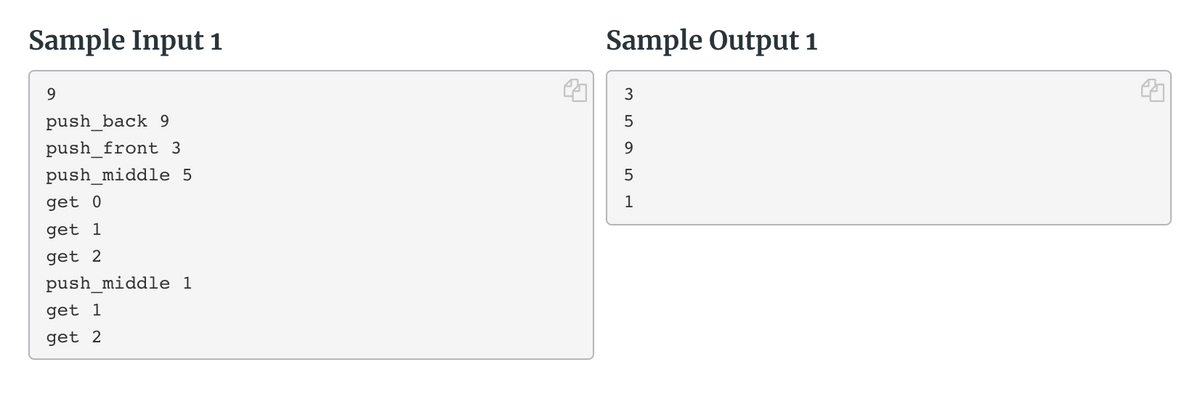You have probably heard about the deque (double-ended queue) data structure, which allows for efficient pushing and popping of elements from both the front and back of the queue. Depending on the implementation, it also allows for efficient random access to any index element of the queue as well. Now, we want you to bring this data structure up to the next level, the teque (triple-ended queue)! The teque supports the following four operations: push_back x: insert the element ?x into the back of the teque. push_front x: insert the element ?x into the front of the teque. push_middle x: insert the element ?x into the middle of the teque. The inserted element ?x now becomes the new middle element of the teque. If ?k is the size of the teque before the insertion, the insertion index for ?x is (?+1)/2(k+1)/2 (using 00-based indexing). get i: prints out the ?thith index element (00-based) of the teque. Input The first line contains an integer ?N (1 ≤ ? ≤ 10^6) denoting the number of operations for the teque. Each of the next ? lines contains a string ?, denoting one of the above commands, followed by one integer ?. If ? is a push_back, push_front, or push_middle command, ?x (1 ≤ ? ≤ 10^9), else for a get command, ? (0 ≤? ≤ (size of teque)−1). We guarantee that the teque is not empty when any get command is given. Output For each get i command, print the value inside the ?thith index element of the teque in a new line.
Hi, asked a question earlier regarding the following problem! So sorry, I was able to understand the explanation of the expert, however the code was in C++ which I am still unfamiliar with. Wanted to ask how we can go about solving this problem in java?
Question:
You have probably heard about the deque (double-ended queue) data structure, which allows for efficient pushing and popping of elements from both the front and back of the queue. Depending on the implementation, it also allows for efficient random access to any index element of the queue as well. Now, we want you to bring this data structure up to the next level, the teque (triple-ended queue)!
The teque supports the following four operations:
-
push_back x: insert the element ?x into the back of the teque.
-
push_front x: insert the element ?x into the front of the teque.
-
push_middle x: insert the element ?x into the middle of the teque. The inserted element ?x now becomes the new middle element of the teque. If ?k is the size of the teque before the insertion, the insertion index for ?x is (?+1)/2(k+1)/2 (using 00-based indexing).
-
get i: prints out the ?thith index element (00-based) of the teque.
Input
The first line contains an integer ?N (1 ≤ ? ≤ 10^6) denoting the number of operations for the teque. Each of the next ? lines contains a string ?, denoting one of the above commands, followed by one integer ?. If ? is a push_back, push_front, or push_middle command, ?x (1 ≤ ? ≤ 10^9), else for a get command, ? (0 ≤? ≤ (size of teque)−1). We guarantee that the teque is not empty when any get command is given.
Output
For each get i command, print the value inside the ?thith index element of the teque in a new line.

Trending now
This is a popular solution!
Step by step
Solved in 2 steps with 3 images


